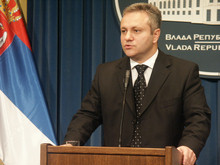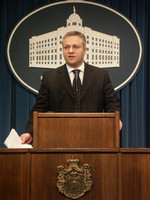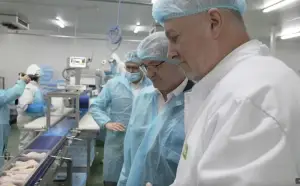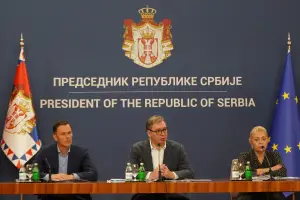Q:
A:
Finance Minister presents economic, fiscal policy plan for 2005
Belgrade,
27 October 2004
Serbian Minister of Finance Mladjan Dinkic presented a plan for economic and fiscal policy in 2005, which he said must be fully implemented so that Serbia's economy can grow.
The first item of the plan is a restrictive monetary policy that is expected to further strengthen hard currency reserves from the current $3.75 billion to over $4 billion next year, said Dinkic, stressing that a stable national currency is the key to this segment of the plan.
A responsible fiscal policy based on a tight budget is the second item of the plan, he said, noting that the policy will seek to further reduce public spending and relieve the tax burden on the economy.
Public spending in 2005 will be trimmed to a record low 45 percent of GDP, Dinkic went on to say, stressing that reduced spending will make Serbia a country with a serious macroeconomic policy for the first time ever.
According to him, the third item stipulates a larger salary span in the public administration, as well as higher salaries for those who work more.
Dinkic confirmed that the Ministry of Public Administration and Local Self-Government and the Ministry of Finance are working on a thorough public administration reform plan. The plan will describe salaries and alter the current 1:4 ratio to 1:8.
The fourth item of the plan calls for speeding up privatisation efforts to boost exports and reduce the foreign trade gap. In 2005, Serbia is expected to raise 2.4 billion dinars in sell-off revenues, five times more than this year, the Minister said.
The restructuring of public enterprises is the fifth and final item of the plan, said Dinkic, noting that public enterprises will be restructured to raise profit through cost cutting rather than price increases.
Dinkic went on to say that the Ministry has projected the October inflation rate at between 0.4 percent and 0.5 percent, down from 1.7 percent in September, insisting that a tight budget policy has helped the National Bank of Serbia (NBS) bring inflation under full control.
Serbia's industrial production has continued to grow at a rate of seven percent, he said, adding that this year's GDP growth will stand at eight percent, the highest growth since 1979.
A responsible fiscal policy based on a tight budget is the second item of the plan, he said, noting that the policy will seek to further reduce public spending and relieve the tax burden on the economy.
Public spending in 2005 will be trimmed to a record low 45 percent of GDP, Dinkic went on to say, stressing that reduced spending will make Serbia a country with a serious macroeconomic policy for the first time ever.
According to him, the third item stipulates a larger salary span in the public administration, as well as higher salaries for those who work more.
Dinkic confirmed that the Ministry of Public Administration and Local Self-Government and the Ministry of Finance are working on a thorough public administration reform plan. The plan will describe salaries and alter the current 1:4 ratio to 1:8.
The fourth item of the plan calls for speeding up privatisation efforts to boost exports and reduce the foreign trade gap. In 2005, Serbia is expected to raise 2.4 billion dinars in sell-off revenues, five times more than this year, the Minister said.
The restructuring of public enterprises is the fifth and final item of the plan, said Dinkic, noting that public enterprises will be restructured to raise profit through cost cutting rather than price increases.
Dinkic went on to say that the Ministry has projected the October inflation rate at between 0.4 percent and 0.5 percent, down from 1.7 percent in September, insisting that a tight budget policy has helped the National Bank of Serbia (NBS) bring inflation under full control.
Serbia's industrial production has continued to grow at a rate of seven percent, he said, adding that this year's GDP growth will stand at eight percent, the highest growth since 1979.
According to Dinkic, per capita GDP is $2,900, around two times higher than in 2001. Romania's per capita GDP is $2,500, Bulgaria's $2,400, Macedonia's $2,160, Albania's $1,940 and Bosnia-Herzegovina's $1,800, he noted.
However, the Minister added that per capita GDP in Croatia and Slovenia is $6,000 and $13,000 respectively.
The economic policy plan calls for Serbia's per capita GDP to top $3,000 in 2005.
Dinkic went on to say that the World Bank will disburse $43 million in the second tranche of this year's loan by the end of the week, adding that the funding will help Serbia repay the first tranche of its debt with the London Club of commercial creditors.
Serbia will receive its first-ever international credit rating by the end of the year, he said, explaining that the credit rating will allow for reducing interest rates on corporate and retail loans and borrowing money from foreign banks that do not have offices in Serbia.
The credit rating will also reduce investment risk and pave the way for a larger inflow of foreign investment, the Minister added.
Dinkic also noted that Serbia and the World Bank will complete negotiations on another, $40 million loan tranche, which the country expects to draw by the end of the year.
He also commended the 2005 economic policy agreement with the IMF, adding that the IMF executive board is due to meet in December to allow Serbia to draw a $90 million tranche under the three-year extended arrangement.
The agreement with the IMF will clear the way for a $700 million write-off on Serbia's debt with the Paris Club of sovereign creditors in mid-2005 in a move that will reduce the country's total public debt to less than 50 percent of GDP, Dinkic concluded.
However, the Minister added that per capita GDP in Croatia and Slovenia is $6,000 and $13,000 respectively.
The economic policy plan calls for Serbia's per capita GDP to top $3,000 in 2005.
Dinkic went on to say that the World Bank will disburse $43 million in the second tranche of this year's loan by the end of the week, adding that the funding will help Serbia repay the first tranche of its debt with the London Club of commercial creditors.
Serbia will receive its first-ever international credit rating by the end of the year, he said, explaining that the credit rating will allow for reducing interest rates on corporate and retail loans and borrowing money from foreign banks that do not have offices in Serbia.
The credit rating will also reduce investment risk and pave the way for a larger inflow of foreign investment, the Minister added.
Dinkic also noted that Serbia and the World Bank will complete negotiations on another, $40 million loan tranche, which the country expects to draw by the end of the year.
He also commended the 2005 economic policy agreement with the IMF, adding that the IMF executive board is due to meet in December to allow Serbia to draw a $90 million tranche under the three-year extended arrangement.
The agreement with the IMF will clear the way for a $700 million write-off on Serbia's debt with the Paris Club of sovereign creditors in mid-2005 in a move that will reduce the country's total public debt to less than 50 percent of GDP, Dinkic concluded.












